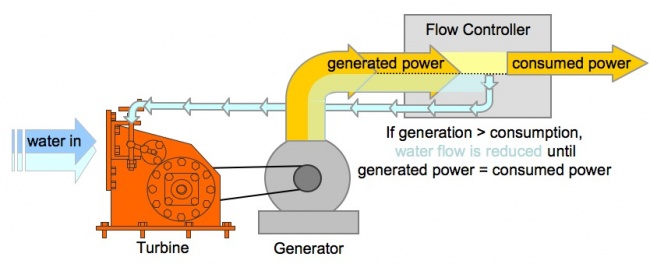Knowledge fuels change
For over a decade, Energypedia has shared free, reliable energy expertise with the world.
We’re now facing a serious funding gap.
Help keep this platform alive — your donation, big or small, truly matters!
Thank you for your support
Difference between revisions of "Control Equipment - Hydropower"
***** (***** | *****) |
***** (***** | *****) m |
||
| Line 75: | Line 75: | ||
=== <span lang="DE" style="font-size: 11pt; font-family: Tahoma; color: black;">Controll Elements</span> === | === <span lang="DE" style="font-size: 11pt; font-family: Tahoma; color: black;">Controll Elements</span> === | ||
| − | ==== <span lang="DE" style="font-size: 11pt; font-family: Tahoma; color: black;">Load | + | ==== <span lang="DE" style="font-size: 11pt; font-family: Tahoma; color: black;">Load controler</span> ==== |
<span lang="DE" style="font-size: 11pt; font-family: Tahoma; color: black;">Electronic circuit, which keeps output power constant in Frequency- and | <span lang="DE" style="font-size: 11pt; font-family: Tahoma; color: black;">Electronic circuit, which keeps output power constant in Frequency- and | ||
| Line 81: | Line 81: | ||
<!--[if gte vml 1]><v:shapetype id="_x0000_t75" coordsize="21600,21600" | <!--[if gte vml 1]><v:shapetype id="_x0000_t75" coordsize="21600,21600" | ||
| − | + | o:spt="75" o:preferrelative="t" path="m@4@5l@4@11@9@11@9@5xe" filled="f" | |
| − | + | stroked="f"> | |
| − | + | <v:stroke joinstyle="miter"/> | |
| − | + | <v:formulas> | |
| − | + | <v:f eqn="if lineDrawn pixelLineWidth 0"/> | |
| − | + | <v:f eqn="sum @0 1 0"/> | |
| − | + | <v:f eqn="sum 0 0 @1"/> | |
| − | + | <v:f eqn="prod @2 1 2"/> | |
| − | + | <v:f eqn="prod @3 21600 pixelWidth"/> | |
| − | + | <v:f eqn="prod @3 21600 pixelHeight"/> | |
| − | + | <v:f eqn="sum @0 0 1"/> | |
| − | + | <v:f eqn="prod @6 1 2"/> | |
| − | + | <v:f eqn="prod @7 21600 pixelWidth"/> | |
| − | + | <v:f eqn="sum @8 21600 0"/> | |
| − | + | <v:f eqn="prod @7 21600 pixelHeight"/> | |
| − | + | <v:f eqn="sum @10 21600 0"/> | |
| − | + | </v:formulas> | |
| − | + | <v:path o:extrusionok="f" gradientshapeok="t" o:connecttype="rect"/> | |
| − | + | <o:lock v:ext="edit" aspectratio="t"/> | |
</v:shapetype><v:shape id="_x0000_s1026" type="#_x0000_t75" style='position:absolute; | </v:shapetype><v:shape id="_x0000_s1026" type="#_x0000_t75" style='position:absolute; | ||
| − | + | margin-left:285.5pt;margin-top:32.8pt;width:231.2pt;height:93.65pt;z-index:1; | |
| − | + | mso-position-horizontal:absolute;mso-position-vertical:absolute'> | |
| − | + | <v:imagedata src="file://localhost/Users/timchiaradia/Library/Caches/TemporaryItems/msoclip1/01/clip_image001.jpg" | |
| − | + | o:title="controller"/> | |
| − | + | <w:wrap type="square"/> | |
</v:shape><![endif]--><!--[if !vml]--><!--[endif]--><span lang="DE" style="font-size: 11pt; font-family: Tahoma; color: black;">Fluctuating | </v:shape><![endif]--><!--[if !vml]--><!--[endif]--><span lang="DE" style="font-size: 11pt; font-family: Tahoma; color: black;">Fluctuating | ||
energy demand requires a mechanism which either regulates the water input into | energy demand requires a mechanism which either regulates the water input into | ||
the turbine (=> flow control) or<span style=""> </span>by diverting excess energy from the consumer connection (=>ballast load). </span><span lang="DE" style="font-size: 11pt; font-family: Tahoma; color: black;"><!--[if !supportEmptyParas]--> | the turbine (=> flow control) or<span style=""> </span>by diverting excess energy from the consumer connection (=>ballast load). </span><span lang="DE" style="font-size: 11pt; font-family: Tahoma; color: black;"><!--[if !supportEmptyParas]--> | ||
| − | </span> | + | </span> |
==== <span lang="DE" style="font-size: 11pt; font-family: Tahoma; color: black;">Flow control:</span> ==== | ==== <span lang="DE" style="font-size: 11pt; font-family: Tahoma; color: black;">Flow control:</span> ==== | ||
Revision as of 15:35, 27 May 2010
Overview:
Function:
Load- or Flow- controller ensure that the power output does not exceed the power demand (e.g. 230V, 50 Hz).
If flow of water in a MHP-station is constant
the energy output of a turbine/generator is constant as well. Power
demand is
usually fluctuating over the time (e.g. day/night). If supply is higher than demand, excess energy must be diverted, dumped. altrenatively the
water flow can be reduced which results in less power output.
In case of more power demand than supply the controler cuts of
the of demand line.
Load controller are placed between generator output and the consumer line.
Controll Elements
Load controler
Electronic circuit, which keeps output power constant in Frequency- and Voltage- parameters.
Fluctuating energy demand requires a mechanism which either regulates the water input into the turbine (=> flow control) or by diverting excess energy from the consumer connection (=>ballast load).
Flow control:
regulates the amount of water into the
turbine in order to match power output and power demand.
Ballast load:
If energy demand is temporarily low, the controller sends excess energy to the Ballst Load. This are usually electrical heaters in water or air.
- ..





















